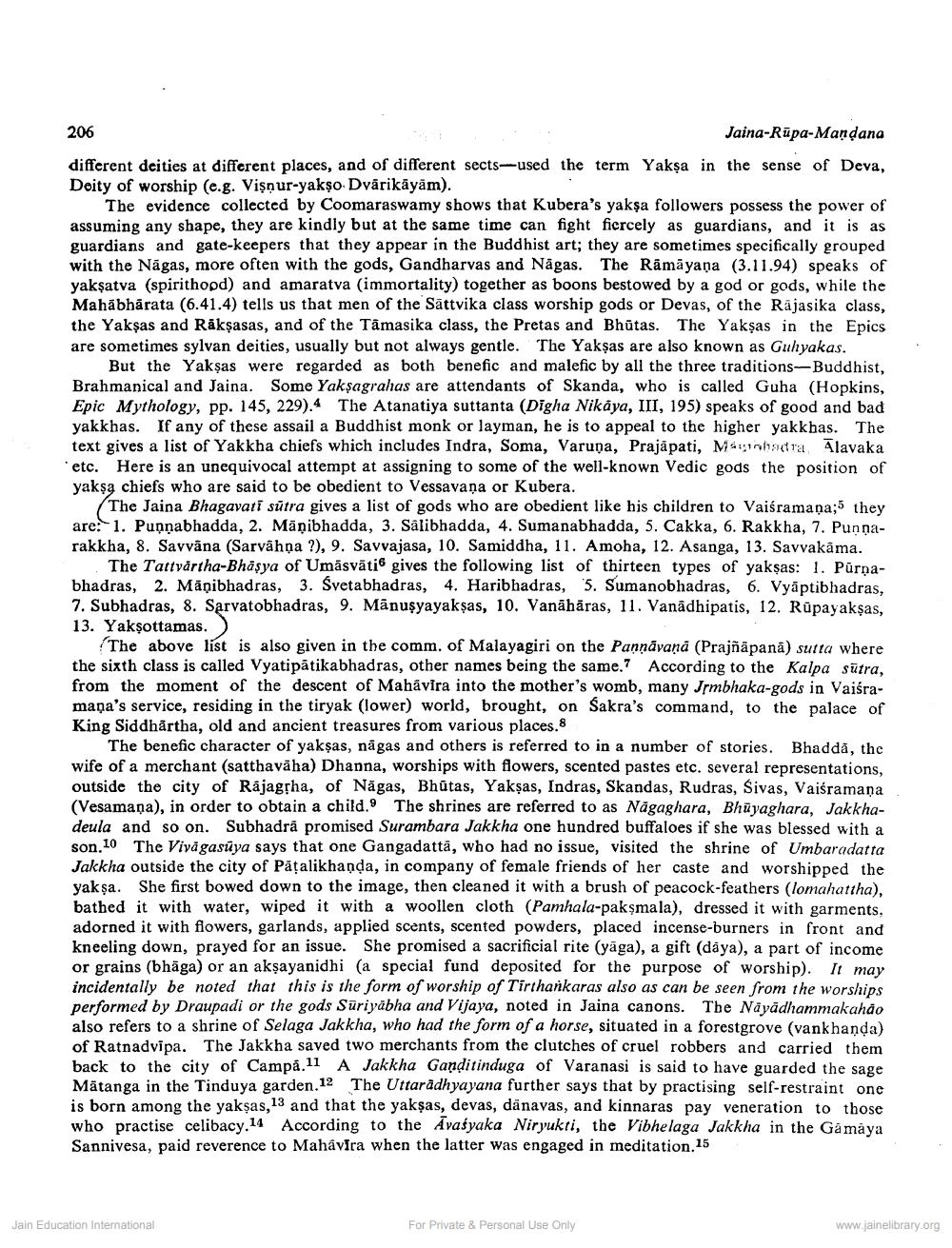________________
206
Jaina-Rūpa-Mandana different deities at different places, and of different sects-used the term Yakşa in the sense of Deva, Doity of worship (e.g. Vişnur-yakso Dvärikāyām).
The evidence collected by Coomaraswamy shows that Kubera's yaksa followers possess the power of assuming any shape, they are kindly but at the same time can fight fiercely as guardians, and it is as guardians and gate-keepers that they appear in the Buddhist art; they are sometimes specifically grouped with the Nāgas, more often with the gods, Gandharvas and Nägas. The Rāmāyaṇa (3.11.94) speaks of yakşatva (spirithopd) and amaratva (immortality) together as boons bestowed by a god or gods, while the Mahabharata (6.41.4) tells us that men of the Sättvika class worship gods or Devas, of the Rajasika class, the Yakşas and Rākşasas, and of the Tamasika class, the Pretas and Bhūtas. The Yakşas in the Epics are sometimes sylvan deities, usually but not always gentle. The Yakşas are also known as Guhyakas.
But the Yakşas were regarded as both benefic and malefic by all the three traditions-Buddhist, Brahmanical and Jaina. Some Yaksagrahas are attendants of Skanda, who is called Guha (Hopkins, Epic Mythology, pp. 145, 229).4 The Atanatiya suttanta (Digha Nikaya, III, 195) speaks of good and bad yakkhas. If any of these assail a Buddhist monk or layman, he is to appeal to the higher yakkhas. The text gives a list of Yakkha chiefs which includes Indra, Soma, Varuna, Prajapati, Matinhadrat Alavaka etc. Here is an unequivocal attempt at assigning to some of the well-known Vedic gods the position of yakşa chiefs who are said to be obedient to Vessavaņa or Kubera.
The Jaina Bhagavati sūtra gives a list of gods who are obedient like his children to Vaiśramaņa;5 they are: 1. Puņnabhadda, 2. Māņibhadda, 3. Salibhadda, 4. Sumanabhadda, 5. Cakka, 6. Rakkha, 7. Punnarakkha, 8. Savvāna (Sarvahna ?), 9. Savvajasa, 10. Samiddha, 11. Amoha, 12. Asanga, 13. Savvakama.
The Tattvärtha-Bhasya of Umāsvātie gives the following list of thirteen types of yakşas: 1. Purnabhadras, 2. Mänibhadras, 3. Svetabhadras, 4. Haribhadras, 5. Sumanobhadras, 6. Vyäptibhadras. 7. Subhadras, 8. Sarvatobhadras, 9. Mānuşyayaksas, 10. Vanāhāras, 11. Vanādhipatis, 12. Rūpayaksas, 13. Yakşottamas.
The above list is also given in the comm. of Malayagiri on the Pannāvanā (Prajñāpanā) sutta where the sixth class is called Vyatipātikabhadras, other names being the same. According to the Kalpa sutra. from the moment of the descent of Mahavira into the mother's womb, many Jrmbhaka-gods in Vaiśramaņa's service, residing in the tiryak (lower) world, brought, on Sakra's command, to the palace of King Siddhartha, old and ancient treasures from various places. 8
The benefic character of yakşas, nāgas and others is referred to in a number of stories. Bhaddă, the wife of a merchant (satthavāha) Dhanna, worships with flowers, scented pastes etc. several representations, outside the city of Rajagpha, of Nägas, Bhūtas, Yakşas, Indras, Skandas, Rudras, Sivas, Vaiśramana (Vesamaņa), in order to obtain a child. The shrines are referred to as Nägaghara, Bhūyaghara, Jakkhadeula and so on. Subhadra promised Surambara Jakkha one hundred buffaloes if she was blessed with a son. 10 The Vivagasūya says that one Gangadatta, who had no issue, visited the shrine of Umbaradatta Jakkha outside the city of Păţalikhanda, in company of female friends of her caste and worshipped the yaksa. She first bowed down to the image, then cleaned it with a brush of peacock-feathers (lomahattha), bathed it with water, wiped it with a woollen cloth (Pamhala-pakşmala), dressed it with garments. adorned it with flowers, garlands, applied scents, scented powders, placed incense-burners in front and kneeling down, prayed for an issue. She promised a sacrificial rite (yāga), a gift (daya), a part of income or grains (bhāga) or an akşayanidhi (a special fund deposited for the purpose of worship). It may incidentally be noted that this is the form of worship of Tirthankaras also as can be seen from the worships performed by Draupadi or the gods Suriyabha and Vijaya, noted in Jaina canons. The Näyädhammakahao also refers to a shrine of Selaga Jakkha, who had the form of a horse, situated in a forestgrove (vankhanda) of Ratnadvipa. The Jakkha saved two merchants from the clutches of cruel robbers and carried them back to the city of Campå.11 A Jakkha Ganditinduga of Varanasi is said to have guarded the sage Mätanga in the Tinduya garden.12 The Uttaradhyayana further says that by practising self-restraint one is born among the yakşas, 13 and that the yaksas, devas, dänavas, and kinnaras pay veneration to those who practise celibacy. 14 According to the Avašyaka Niryukti, the Vibhelaga Jakkha in the Gamāya Sannivesa, paid reverence to Mahavira when the latter was engaged in meditation. 15
Jain Education International
For Private & Personal Use Only
www.jainelibrary.org




